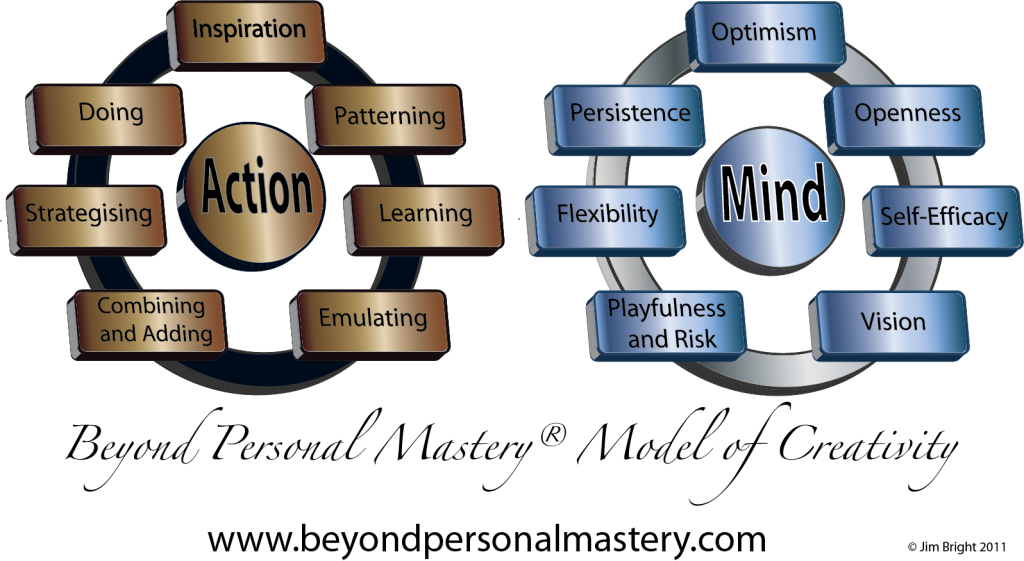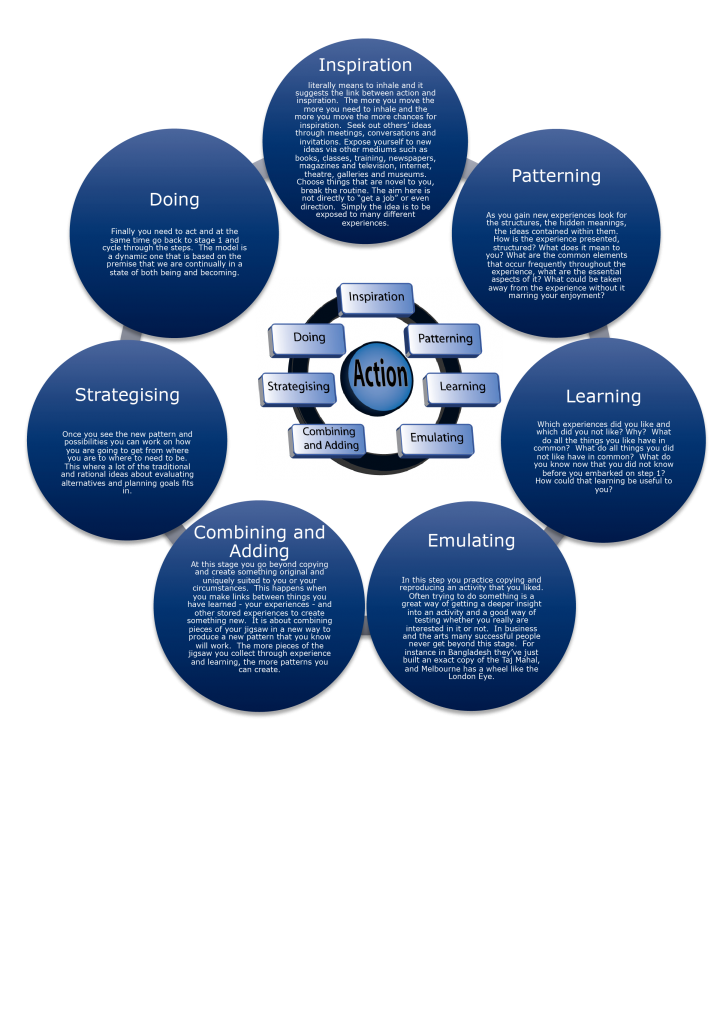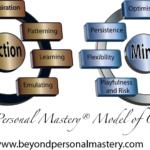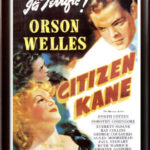Life Creativity – Applying Beyond Personal Mastery® to Life Changes
I want to share with you my model of Creativity that provides practical steps to enhance Life and Career changes. I will describe the model in this post, and in subsequent ones discuss each of the steps in greater detail.
Here is the Beyond Personal Mastery® model.
Beyond Personal Mastery® and its brother Beyond Corporate Mastery® are really two related models comprising Action and Mind steps. The Action steps, as the name implies, describe the actions that lead to creativity. The Mind steps are attitudes and dispositions that have been shown by research to support and promote the Action Steps and hence creativity.
The Action Steps model is based on the following ideas derived from the research into creativity:
- Little “c” creativity involves combining ideas in a new way that has some amusement value, novelty, or modest utility for the person creating and perhaps their immediate circle
- Big “c” creativity involves combining ideas in a new way that solves or contributes to solving a problem deemed important by others and society generally
- Ideas are combined when previously stored knowledge is combined in a new way, or old knowledge and new experiences are combined to form a new idea
- Innovation occurs when Strategies are developed and Implemented to put the creative idea into practice or practical use
- Creativity starts with the Inspiration stage – meaning literally breathing in or taking in new ideas or experience. In my model this does not mean being impressed, excited or energized that comes later. The Inspiration stage is about taking in new information and experiences. There are a series of ways of improving your Inspiration. I’ll address these in another post.
- The new information coming into the system is processed into Patterns. This often happens automatically and unconsciously. However consciously examining the new information for patterns will yield richer, more subtle and complex patterns.
- Once the structure of the new information is understood in terms of patterns, the Learning stage classifies patterns into pre-existing categories, schema and mental models. or generates new categories for information deemed novel. (The more rich the Patterns generated in the previous stage, the greater the chance of new categories being generated). During this stage, new information can be rehearsed to ensure it is fully understood. There are, of course, myriad different ways of enhancing learning. See future post.
- Emulating or copying or leveraging is the stage where one has mastered the new information and can repeat it, play it, do it, understand it, explain it or use it. Once this stage is reached, you have attained Mastery. One of the biggest barriers to creativity is people trying to avoid Emulating, but it is an essential step. See later post.
- Combining and Adding is the step when we go beyond mastery into creativity, hence the name of the model. It is in this stage that we take some mastered idea, knowledge or practice and combine it either with another previously mastered idea or with a current Inspiration. When this happens – a solution or new pathway appears, often suddenly, and it gives rise to the “Aha” moment. This is often the exciting and energizing time. There are lots of techniques to help people with the combining and adding.
- Once we have the new solution, it is the appropriate time to enter the Strategizing stage to develop plans and goals to implement the creation. Nearly all personal and business change models start at this point and tend to neglect the previous steps that should now be quite obvious as being essential. The solution/creation determines what can be a goal, a goal does not provide the solution. This is often misunderstood. See a future post for more on how to do this.
- Finally, we must execute our plans in the Doing Stage. This again is non-negotiable. Because inevitably given the complexity of the world, something will go not strictly according to the plan, and sometimes things will go very differently indeed. These “failures” or “unexpected by products” provide new Inspirations, and so the cycle can start again.
The Action Steps explained in general terms. (click on the graphic to open in a new window where you can zoom in and enlarge image)
The Mind Steps model
The Mind Steps are likely to be more familiar to many people as the terms used here are commonly used and understood in counseling and coaching. I will briefly explain here why they are included. I will go into greater detail in future posts.
Optimism
The great contribution of the Positive Psychology movement, and its champions like Martin Seligman is that we now know that optimism can be learned, developed and enhanced. Optimism is an important predictor of people’s willingness to change or an organization’s ability to change. People who believe that things can be better in the futrure are more likely to be motivated to try to explore possible futures. The are ways of boosting optimism that I’ll cover in future posts.
Openness
Creative people and organizations are open systems. That is they are curious about the world, and accept that there are always interesting things to learn, and different ways of doing things. This mindset increases their chances of having new inspirations and patterning them in novel ways. It also increases their chances of combining and adding in novel ways. Some of the ways you can increase openness will be covered in a later post.
Self-Efficacy
Is defined by Bandura as the degree to which a person believes that they are capable of achieving in a particular domain. Self efficacy has been shown to be a strong predictor of success in a range of different areas such as completing training, preparing for a big event etc. Increasing self-efficacy can be a useful way of fostering change. Ways of increasing self-efficacy will be covered in a later post.
Vision
Vision refers to a collection of qualities such as Purpose, Spirituality, Connection, Limits, and Imperfection. It is about fostering a sense of a bigger picture, and encouraging people to ask questions such as Why am I doing this? To whom am I connected? Whom do I serve? How can I be useful? What place can I or do I occupy in society/family/friends? How can I serve others? Do I have a choice? What matters to me? Research shows that fostering this type of thinking can sustain people and reduce stress. It can help people persist, or even try in the first place.
Playfulness & Risk
Increasingly research is showing that play is a potent form of learning, and that many western educational systems have under-valued its central importance. Furthermore risk-taking is often misunderstood or characterized in pendulum attractor terms as
“risk-free or reckless”. Nearly all creartivity has arisen from play, risk taking or both. There are ways to develop appropriate playfulness and risk taking and I’ll show you how in a future post.
Flexibility
In a world that is rapidly changing, uncertain, complex and chaotic, the ability to be flexible is very important. Flexibility of mind is centrally important for playfulness, inventiveness, creativity, overcoming barriers, seeking inspiration, combining and adding, strategizing and doing.
Persistence
The importance of keeping on going, in the face of adversity, loss of enthusiasm, boredom, obstacles, set-backs, criticism, despondency, ennui and the rest cannot be over-estimated. Others prefer to capture some of these ideas under the term “Resilience”. Much of what is done under this term would fit in the Persistence category. I prefer the term Persistence because the word more strongly implies movement, and movement in a self-determined direction. I’ll post more on how to develop resilience later.
And this is Life Creativity – Applying Beyond Personal Mastery® to Life Changes!
Related Posts










Hi young Jim This is a flash from the past; Foss Smith formally of Kings Baptist Gramma School
Yes the the Old Dog retired and I was working with a young man, I KNOW I AM RETblabla.
An to my surprise here I am quoting Jim B pearl of wisdom thanx mate your the best; but I beat you hands down on drums.
if your in Adelaide give us a call 0411701148 Have a great new your Foss S